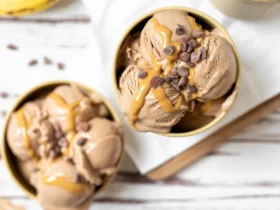You ever wake up on a Saturday and just know that toast isn’t going to cut it? You want something special, but the idea of standing over a hot pan, flipping individual slices of French toast, sounds like a whole lot of work. I get it.
This recipe is the answer. It’s all the gooey, custardy goodness of French toast, but you just toss it all in a dish and bake it. You’re going to learn how to make a Baked French Toast Casserole that tastes like you worked on it for hours, but it’s actually super simple.
This is the kind of breakfast that makes the whole house smell amazing and gets everyone excited to come to the table. Seriously, it’s a game-changer for lazy weekend mornings or when you have people over.
What You’ll Need
Getting your ingredients ready first is probably the smartest thing you can do in the kitchen. It’s what the pros call “mise en place,” which is just a fancy French way of saying “get your stuff together.” It stops that mid-recipe panic when you can’t find the cinnamon.
For this recipe, stale bread is your best friend. If your bread is fresh, just leave the slices out on the counter for a few hours or pop them in a low-heat oven for about 10 minutes. You want it a little dried out so it can soak up all the good stuff without turning to mush.
Here’s the breakdown of everything for the casserole itself.
| Ingredient | Amount |
|---|---|
| Stale Bread (Cubed) | 1 loaf (1 pound) |
| Large Eggs | 8 |
| Whole Milk | 2 cups |
| Heavy Cream | 1 cup |
| Granulated Sugar | ¾ cup |
| Vanilla Extract | 1 tablespoon |
| Ground Cinnamon | 2 teaspoons |
| Ground Nutmeg | ½ teaspoon |
| Salt | ¼ teaspoon |
The Secret Weapon: Streusel Topping
Okay, the casserole is great on its own, but this topping is what takes it over the top. It creates this crunchy, sweet, buttery layer that is just ridiculously good. Don’t skip this part, I’m telling you. It adds maybe five minutes of work and makes the final dish ten times better.
| Ingredient | Amount |
|---|---|
| All-Purpose Flour | ½ cup |
| Light Brown Sugar | ½ cup (packed) |
| Ground Cinnamon | 1 teaspoon |
| Cold Butter (Cubed) | ½ cup (1 stick) |
The Tools for the Job
You don’t need a bunch of fancy equipment for this. It’s one of the reasons I love making it. You probably have everything you need in your kitchen right now, which is always a plus. No last-minute trips to the store for a special pan you’ll never use again.
| Tool | Quantity |
|---|---|
| Baking Dish | 9×13 inch |
| Large Mixing Bowl | 1 |
| Medium Mixing Bowl | 1 |
| Whisk | 1 |
| Measuring Cups & Spoons | 1 set |
Step-by-Step: Let’s Make This Thing
Alright, this is where the fun starts. I’m going to walk you through it one step at a time. It’s pretty much impossible to mess this up, so just relax and follow along. The whole process is super forgiving.
Step 1: Get the Pan Ready
First things first, grab your 9×13 inch baking dish. Grease it really well with butter or some non-stick spray. You don’t want any of this deliciousness getting stuck to the bottom. Then, spread your cubed bread all over the bottom of the dish in an even layer.
Step 2: Make the Custard
Now, get that large mixing bowl. Crack all 8 eggs into it and give them a good whisk until they’re broken up and a little frothy. Then, pour in the whole milk, heavy cream, granulated sugar, vanilla extract, cinnamon, nutmeg, and salt. Whisk it all together until it’s totally combined and the sugar has dissolved. (You shouldn’t feel any grainy bits at the bottom).
Step 3: Time for a Soak
Carefully pour that beautiful custard mixture all over the bread cubes in the baking dish. Try to pour it as evenly as possible. Once it’s all in there, gently press down on the bread with a spatula to make sure every single piece gets a chance to soak up the custard. This is key.
Step 4: Let It Rest
Cover the dish with plastic wrap or foil and stick it in the fridge. You need to let it sit for at least 4 hours, but honestly, overnight is even better. This is what makes the casserole so good—it gives the bread time to really absorb all that flavor. This is not a step to rush!
Step 5: Preheat and Prep the Topping
When you’re ready to bake, pull the dish out of the fridge and let it sit on the counter while your oven preheats to 350°F (175°C). Now, let’s make that amazing streusel. In your medium bowl, mix the all-purpose flour, brown sugar, and cinnamon together.
Step 6: Finish the Streusel
Add your cold, cubed butter to the flour mixture. Using your fingertips or a pastry cutter, work the butter into the dry ingredients until it looks like coarse, crumbly sand with some pea-sized chunks of butter still visible. Those little butter pockets are what make it so good.
Step 7: Top and Bake
Sprinkle the streusel topping evenly all over the top of the casserole. Don’t be shy with it. Now, place it in the preheated oven and bake for 45 to 55 minutes. You’ll know it’s done when the top is golden brown and crispy, and the center doesn’t jiggle when you gently shake the pan.
Step 8: The Hardest Part—Waiting
Once it’s out of the oven, you have to let it cool for at least 10 minutes before you cut into it. This is probably the hardest step because it smells so incredible. But letting it rest helps it set up properly so you can get nice clean slices. Serve it warm with maple syrup, fresh berries, or a little powdered sugar.
Pro Tips from My Kitchen
I’ve made this casserole more times than I can count, and I’ve learned a few things along the way. These little tricks can make a big difference between a good casserole and a great one.
1. Stale Bread is Not a Suggestion.
I mentioned it before, but it’s the most important rule. Fresh, soft bread has too much moisture. When you pour the custard over it, it just falls apart and turns into a sad, soggy mess at the bottom of your pan. Stale, dry bread acts like a sponge, soaking up the custard perfectly while still holding its shape. This is how you get that perfect bread-pudding-like texture inside.
2. Don’t Be Scared of Full-Fat Dairy.
This is not the time to reach for the skim milk. The heavy cream and whole milk are what make the custard rich, creamy, and satisfying. The fat content helps create that luxurious texture and prevents the eggs from getting rubbery. You can use lower-fat alternatives, but the final result just won’t be as decadent. Trust me on this one.
3. Press It Down, Then Leave It Alone.
When you pour the custard over the bread, it’s really important to press the bread down gently so everything is submerged. But after that, leave it be! Don’t stir it or mix it around. You want the layers to set up properly. Pushing it down ensures every piece gets soaked, and then letting it rest undisturbed is what creates that perfect, sliceable casserole.
Let’s Talk Swaps: Substitutions and Fun Variations
One of the best things about a recipe like this is how easy it is to change things up. You can swap out ingredients based on what you have or what you’re in the mood for. Here are a few ideas to get you started.
For the Bread:
- Brioche or Challah: These are my top choices. They’re rich, eggy breads that make the casserole extra decadent.
- Sourdough: If you like a little tang to balance the sweetness, sourdough is an amazing option.
- Croissants: Yes, you can use stale croissants. It’s next-level amazing and so buttery.
For the Dairy:
- Non-Dairy Milk: You can use almond milk, oat milk, or soy milk instead of whole milk. Oat milk is probably the creamiest option.
- Coconut Cream: For a different flavor profile, you can swap the heavy cream for full-fat canned coconut cream.
Fun Add-Ins:
- Fruit: Toss a cup of blueberries, raspberries, or chopped apples in with the bread cubes.
- Chocolate: A handful of chocolate chips sprinkled in before baking never hurt anyone.
- Nuts: Add some chopped pecans or walnuts to the streusel topping for extra crunch.
Can I Make This Ahead of Time?
Yes! And you absolutely should. This casserole is the perfect make-ahead breakfast.
You can assemble the entire thing the night before—bread, custard, everything. Cover it tightly and keep it in the fridge overnight. The next morning, all you have to do is make the quick streusel topping, sprinkle it on, and pop the casserole in the oven. It actually tastes better when it has all that time to soak.
This makes it perfect for holidays like Christmas morning or for any weekend when you want a delicious breakfast without having to wake up at the crack of dawn to cook.
What to Do With Leftovers
If you happen to have any leftovers, first of all, I’m surprised. But storing them is super easy.
Just let the casserole cool completely, then cover the dish with plastic wrap or transfer slices to an airtight container. It will keep in the refrigerator for up to 3 days.
To reheat, you can pop a slice in the microwave for about a minute. Or, for a crispier top, put it back in the oven at 350°F for about 10-15 minutes until it’s warmed through. It tastes almost as good as it did on day one.
Quick FAQs
Q1. Why is my French toast casserole soggy on the bottom?
Ans: This usually happens for two reasons: your bread was too fresh, or you didn’t let it soak long enough. Make sure your bread is nice and stale so it can absorb the custard properly.
Q2. Can I freeze this casserole?
Ans: Yep! You can freeze it baked or unbaked. For a baked casserole, let it cool completely, wrap it tightly, and freeze for up to 2 months. Thaw it in the fridge overnight before reheating.
Q3. Can I use a different size pan?
Ans: You can, but you’ll need to adjust the baking time. A smaller, deeper pan will take longer to cook, while a larger, shallower pan will cook faster. Just keep an eye on it.
Q4. I’m out of heavy cream. What can I use?
Ans: You can use all whole milk in a pinch. The custard won’t be quite as rich or thick, but it will still be delicious.
Wrapping Up
So there you have it. This Baked French Toast Casserole is one of those recipes that looks and tastes impressive, but it’s secretly one of the easiest things you can make. It’s perfect for a lazy Sunday, a big family brunch, or anytime you just need a little comfort food.
The smell alone is worth it. It fills your entire home with the scent of cinnamon, butter, and vanilla, which is pretty much the best way to wake up.
Now it’s your turn. Give this recipe a try this weekend. I promise you won’t regret it. When you do, come back and leave a comment below. I’d love to hear how it turned out for you or if you tried any fun variations






Leave a Reply